Discover the sensory delights and communal nature of golf under lights in Australia.

I instantly regretted one thing upon finally making my first venture to Topgolf during a family holiday to the Gold Coast in May: not going at night. Our Friday lunchtime booking was ideal for combining the whacking of a stack of balls with a meal in glorious autumn sunshine, but for a debut visit it was a shame to not see the place all lit up, for nighttime is when Topgolf’s full vibrancy comes alive.
For so long, golf and darkness held a mutually exclusive relationship – we simply assumed they couldn’t exist together. We even lobbed humour at the incongruity. Who hasn’t heard the joke about the member who showed up for a social game at their home club only to be told the course was closed because the club was hosting a special event for visually impaired golfers. Then, instead of gushing over the club’s kind hospitality, the member asks, “Why couldn’t they play at night?”
Modern life feels more and more about squeezing every available skerrick from every day, so why should golf be limited to daylight hours? It’s a sentiment that goes all the way to the top of the game here.
“Why is it that golf events have to be played in the daytime?” wonders James Sutherland, chief executive of Golf Australia. “Why is it that they have to be played over 18 holes? Maybe you can play a golf event over a [shorter] period of time, over [fewer] holes and you light up four holes or six holes so you can show it in the evening during prime-time television hours when three, four, five times as many people are watching?”
Night tournaments might be a way off right now, but there are already multiple venues across Australia where everyday golfers can play – and compete – after nightfall.
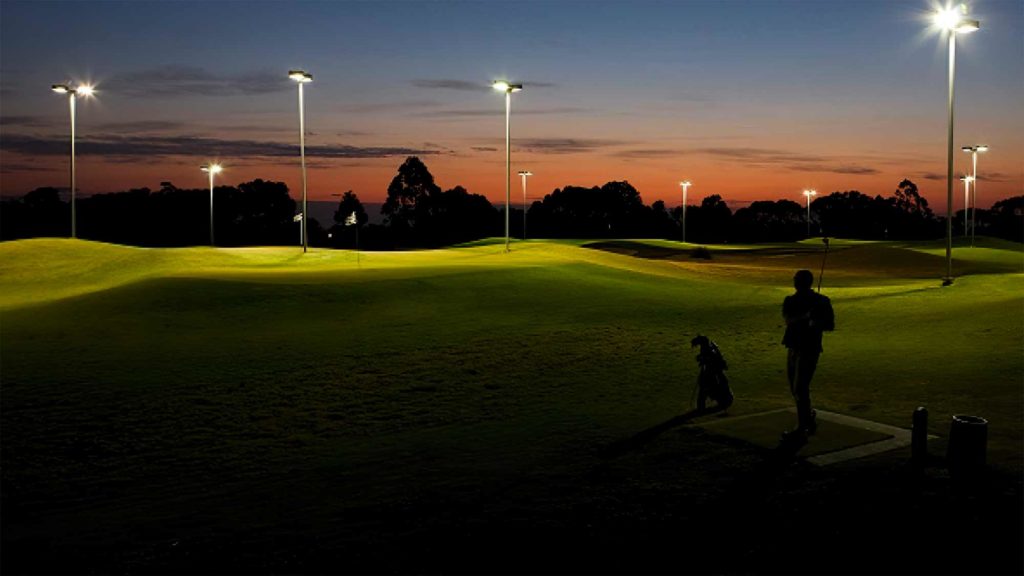
The coast with the most
Night golf presents distinctive challenges and, according to regulars, it takes time to acclimate yourself and your swing to the different sensations. Misleading lines on the greens and artificial shadows are difficult to interpret at first, but they provide an entertaining level of unpredictability to the game.
“It’s kind of like driving at night,” says one club general manager. “You’ve got the streetlights, you’ve got plenty of light to see, but there are dark nooks and crannies. It’s imperfect, but your eyes adjust to it. It’s part of the challenge.”
Yet with the challenge comes convenience. The ability to book 8pm
tee-times is what makes regular gatherings possible, especially for groups for which daytime work schedules and family priorities rarely align.
Emerald Lakes Golf Club on the Gold Coast gets it. The club has a catch-cry of “Night or day, come and play” and was among the first Australian golf courses to add floodlights when it did so nearly 20 years ago. General manager Christopher Bagley says the south-east Queensland climate means the appeal for night golf is at its highest in spring and summer but essentially remains an option all year.
Half of the 18 holes at Emerald Lakes are lit, meaning golfers seeking a full round late in the day can play the unlit front nine until sunset then move across to the floodlit back nine. From an administration perspective, clubs offering nighttime play naturally require staff to be on-site for longer each day (which is not a concern at Emerald Lakes as the club operates its driving range at night).
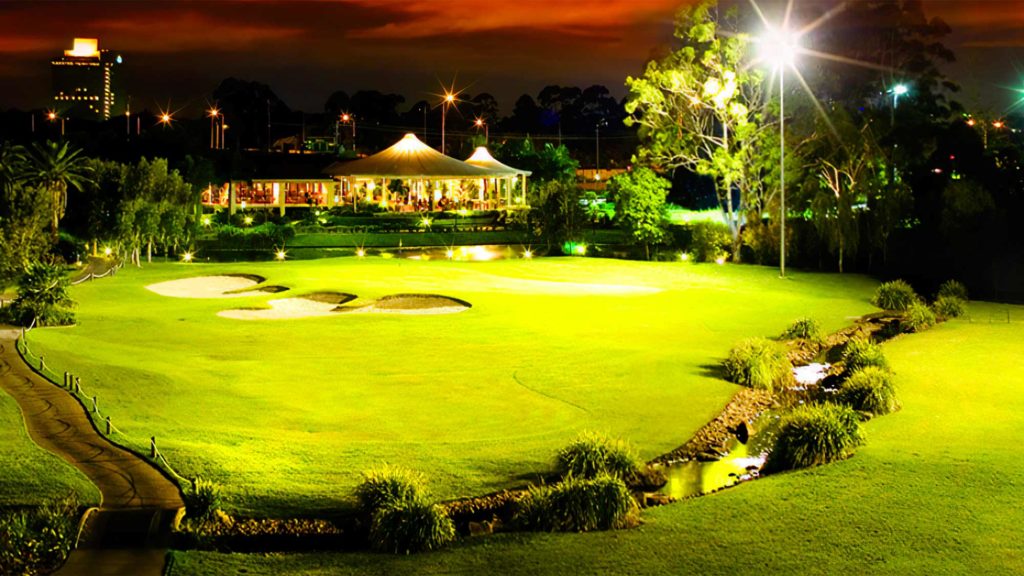
The pandemic has condensed the allure to a degree. Prior to the onset of COVID-19, Emerald Lakes operated night golf every evening but timesheets on Friday, Saturday and Sunday nights proved to be the most difficult to fill. As such, the club now offers night golf only from Mondays to Thursdays. While golf has experienced a COVID-related boom, that hasn’t necessarily translated into the parts of the day when the sun doesn’t shine.
“It was a little bit of a novelty,” Bagley says of the initial curiosity, “and people were going, ‘This is awesome! How good’s this?’ but that novelty’s worn off for the vast majority. And while it’s good to do it every so often, it’s certainty not something that people tend to do regularly.”
Bagley adds that night golf is mostly the domain of the social golfer rather than Emerald Lakes’ growing membership.
“Those that choose to play on those Mondays through Thursdays, they’re your hard-core ones, but by percentage they are well and truly the minority of our membership. True golf is better played during the day, but [night golf is] a novelty and can be a lot of fun if you’ve got the right group of people going around the course, having a few drinks, having a few laughs.”
Australia has only a handful of night-golf facilities stretching beyond a floodlit driving range or mini-golf course. Coincidentally, two of them are a mere kilometre or so apart, as just down the road from Emerald Lakes is the KDV Sport complex where nine holes remain under lights from 4:30pm to 9pm daily. As with its neighbour, there’s also a driving range, plus a mini-golf course.
In Sydney, Terrey Hills Par 3 Golf Course in the northern suburbs is the only floodlit golf layout in the city. With a total length of 1,000 metres and holes ranging from 38 to 88 metres, it has been an ideal domain to take a couple of balls, a few wedges and perhaps a few beers ever since it opened in January 2000. The small, raised and firm greens make it a perfect place for regular golfers to sharpen their short games and for irregular players to enjoy a bit of fun.
Light towers dot the landscape of the quarry-turned-rubbish-tip-turned-golf-course, which offers views of Ku-ring-gai Chase National Park and allows tee-times from 8am to 8pm. It’s a domain for social and expert players alike, says Terrey Hills Par 3 managing director Peter Miller, although a growing number of good golfers are finding their way there, including some of the state’s rising stars. Part of the course’s appeal lies in the way it asks serious questions of your short game while remaining fun and enjoyable.
“It’s always been social, but there’s more and more good golfers coming now and pros bringing their lessons up here,” Miller says. “We get Golf NSW bringing their high performance team here. They see it as a good way of honing their short games.”
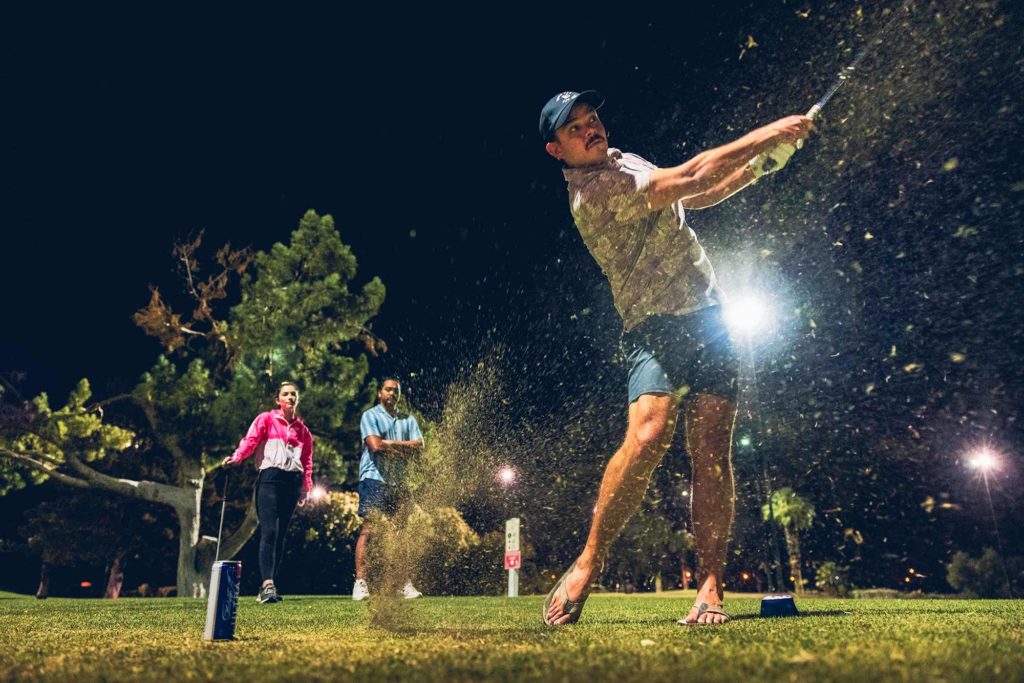
Power plays
Why don’t we see more floodlit golf courses, especially as golfer demand appears to be there? The cost of electricity is a primary factor. Bagley from Emerald Lakes says 17 green fee-paying golfers are required each night to cover the cost of running the lights alone, with green fees for a night nine priced at $30 or $45 in a cart. Miller from Terrey Hills Par 3 wouldn’t be drawn on details at his facility but did say it is a “considerable” aspect to operating a night-golf facility.
“It’s quite an investment,” he says. “A lot of people are probably sitting back, looking at it and wondering whether it’s worth it.”
The few night courses here tend to be par-3 or pitch-and-putt setups, usually with just nine holes of an 18-hole layout lit, but outside Australia, night golf courses are more likely to be full-length, 18-hole layouts lit at night and through the early morning hours.
This writer’s first ever experience with night golf came on the closing holes at Sutera Harbour, a 27-hole Graham Marsh design in the Malaysian part of Borneo. Being able to start a round later in the afternoon and finish after dark was a godsend in the sultry equatorial heat, although adjusting to the different light and more prominent shadows wasn’t straightforward. In a similar climate, Marina Bay Golf Course in Singapore is the island’s only 18-hole public course. The 6,500-metre layout is illuminated
by 186 light masts. Golf has been enjoying a surge in Singapore, and night play serves as a good environment for beginners to experiment with the game.
Li Ann Wan picked up golf less than a year ago to help her better network with clients, and she finds night to be the most beautiful, enjoyable and accessible time to play. Plus, it’s a great way to avoid the almost unbearable Singapore humidity.
In the United States, Las Vegas – a true 24-hour town – has a strong night-golf community, while more facilities are on offer in Florida. Lest you think night golf is confined to climatically appealing places, even Connecticut with its frigid winters has night golf.
It’s also worth remembering night golf caught the attention of golf’s biggest name. As the sport looks to better serve and retain new customers, night golf could be an attractive option. It was good enough for Tiger Woods. One of the places he grew up playing was Heartwell Golf Course, a 1,960-metre par-3 course in Long Beach, California, where he would play until midnight. “It’s just really different,” Woods said at the 2000 Battle of Bighorn, where the final four holes were played under the lights. “You have different shadows on the ball, and it’s really hard to see your lines and get a feel for what the break is. The tee shots are all right. The second shots are all right. [The challenge is] seeing what the ball is going to do on the ground.”
Just one of the charming quirks of golf after dark.
– Additional reporting by Gabrielle Herzig
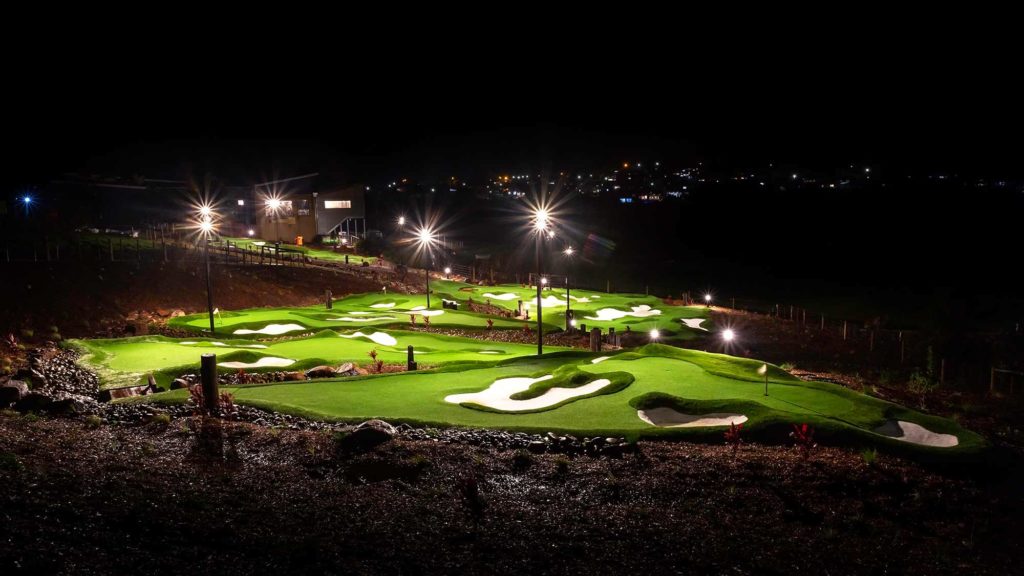
Bright lights
Plenty of driving ranges across Australia are lit for night play, as are a few of the burgeoning number of mini-golf courses. Here’s a selection:
• Topgolf, Gold Coast: stays open “until late” every night of the week.
• Maroochy River Golf Club, Sunshine Coast: mini-golf tee-times up to 9pm on Wednesdays to Sundays; 7 o’clock the other nights.
• Thornleigh Golf Centre, Sydney: the driving range and two mini-golf courses are lit as late as 10pm.
• Links Shell Cove, Wollongong: the Shanx mini-golf course [above] stays open as late as 9pm.
• Curlewis Golf Club, Victoria: the driving range and mini-golf course are lit until 10 o’clock every night.
• Wembley Golf Course, Perth: the driving range and mini-golf course are open and lit until 8 o’clock every night.
• Whaleback Golf Course, Perth: the driving range stays open as late as 8:30pm.

Night owls
South-eastern Melbourne is a hub of golf in Australia, but not usually after dark. Yet when the Sandbelt region’s world-class courses close for the day, that’s when golfstudio at Mordialloc [above] comes into its own.
Australia’s largest indoor golf centre – at more than 1,700 square metres – is open 24 hours a day, seven days a week, but it’s often at night that golfers utilise the studio most. Gyms operating 24 hours a day is now commonplace in that market, so don’t sell short the appeal of an indoor night-golf facility, which is enticing either by necessity or because eager golfers will grab any opportunity to hit balls or take a lesson.
“We thought it was gimmicky at first, but we under-estimated the number of shift-workers, doctors and other people working irregular hours,” says PGA professional JD Coulon, golfstudio’s head coach. Before the most recent lockdowns in Melbourne, Coulon says they had bookings spanning every hour of the day. One member was showing up on cue at 11pm, every night.
It’s a first-class facility – golfstudio aims to set a benchmark in golf practice in Australia and includes TrackMan-fitted hitting bays, simulators, a putting zone, a Sandbelt-style indoor bunker, as well as coaching from PGA professionals with lessons available until midnight.
A variety of membership categories are available (most ranging from $20 to $50 per week), with members in the top-tier categories given access to golfstudio at any hour of any day (visit golfstudio.com.au for full details).
Elsewhere, it is commonplace for PGA pros to conduct lessons at night, including the current PGA of Australia National Club Pro of the Year, Jo Bannerman. While she will teach until 7pm every day – and a colleague up until 9pm – Thursday nights are a focus for golfers wanting after-dark lessons at Banners Golf Tech Centre. Offering night tuition is something of a throwback to Bannerman’s trainee days when she gave lessons at Sydney’s iconic Sharpies Golf House in the heart of the CBD. Today, she’s equipped with the full gamut of modern technology. Her Banners Golf setup at Cumberland Country Golf Club in Sydney’s west includes TrackMan, K-Vest, SAM PuttLab, TPI screening, FocusBand, video analysis and more (visit bannersgolf.com.au for more information).
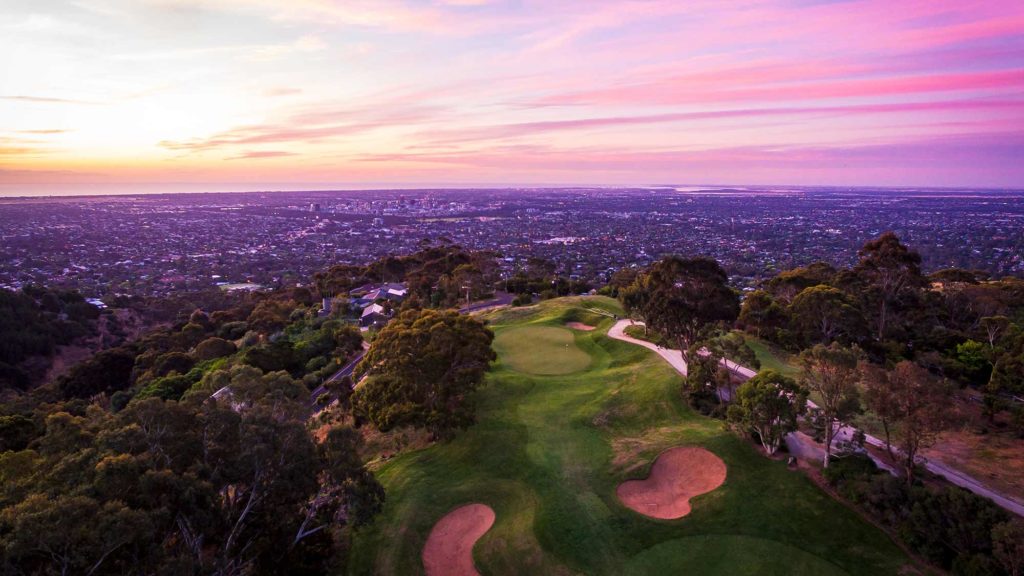
No lights? No problem!
Not every golf course is equipped to provide after-dark play. Establishing and running light towers is no easy task and makes zero sense –logistically, cost-wise or both – for many golf clubs. Yet there are other ways to entice people to venture to golf clubs as the sun sets and after dark.
Adelaide’s Mount Osmond Golf Club [above] has come up with a clever way to engage its members and all golfers late in the day through its regular Friday Night Lights events. One Friday per month during the daylight-savings period of October to March, a nine-hole competition tees off about 5:30pm followed by some genuine South Australian hospitality. The field is generally an even split of those enjoying a social hit and truly competitive golfers, while afterwards all players are encouraged to stay and enjoy a meal and a drink as a different brewery or distillery provides products each month.
Beginning in 2018, the first Friday Night Lights welcomed just 20 players but grew to 110 for the most recent event in March 2021. The new season begins this month and will again take place once a month for six months with a different local producer showcasing products each time.
Arlen Kaesler, Mount Osmond’s business development and marketing manager, says more than 850 golfers have participated since it started.
“The popularity of Friday Night Lights continues to grow with each event as word spreads across Adelaide,” Kaesler says, adding that the combination of the time of day and the speed of a nine-hole round holds a lot of appeal, leading to plenty of returning players.
“The series has been incredibly popular with younger golfers, many of who are repeat attendees. The events are affordable, relaxed and open to golfers of any ability. While there is a nine-hole competition running on the night for the more serious golfers, we encourage anyone to come up for a hit, a bit of fun and a meal and drink with their friends.
“As a club we’re always looking to create new events to bring both new and younger golfers to our club and help grow the sport in Adelaide.”
For the upcoming season, Mount Osmond will have Callaway Golf providing prizes for golfers across all events. The club also continues to work with a number of South Australian breweries, distilleries and wineries.




